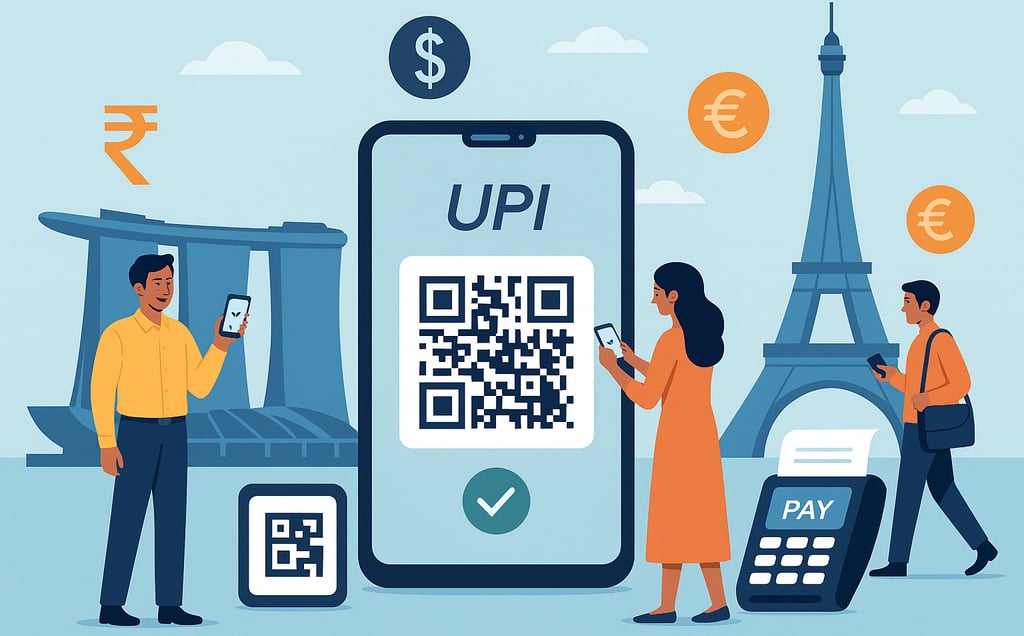UPI for International Payments: How India is Expanding Its Digital Payment Revolution Globally
4/15/20252 min read


UPI for International Payments: How India is Expanding Its Digital Payment Revolution Globally (2025 Update)
In 2025, UPI for international payments is no longer just a concept—it’s a reality. India’s Unified Payments Interface (UPI), which transformed domestic transactions, is now extending its reach across borders. With active partnerships in countries such as the UAE, Singapore, France, and Sri Lanka, this expansion signals India’s bold move toward global fintech leadership.
What is UPI and Why It Matters
To begin with, UPI is a real-time payment system developed by the National Payments Corporation of India (NPCI). It enables instant fund transfers between bank accounts through mobile apps. Unlike traditional banking methods, UPI is faster, more affordable, and accessible 24/7. Consequently, UPI for international payments introduces unprecedented convenience to Indians abroad.
Countries Where UPI is Now Active
So far, India has established UPI integration in several countries:
UAE: Indian travelers can now make payments using UPI at stores and airports.
Singapore: Through the PayNow-UPI linkage, users enjoy seamless transfers between India and Singapore.
Nepal & Bhutan: These neighbors now support real-time UPI transactions.
France: Tourists from India can pay with UPI at many retail locations.
Sri Lanka & Mauritius: NPCI is working with fintech firms to expand UPI usage.
These partnerships reduce friction in remittances, enhance merchant acceptance, and simplify cross-border payments.
How It Benefits Indian Users
With this global expansion, Indians abroad can perform transactions with ease. For example, they can scan QR codes and pay merchants directly using their Indian bank accounts. Additionally, they save on forex conversion fees and eliminate the need for local cash or cards. Businesses, too, benefit by receiving payments faster and at lower processing costs.
Furthermore, travelers find UPI to be a familiar and secure method, reducing the dependency on foreign wallets or complicated payment systems. Overall, it enhances user confidence and reduces transaction complexity.
Impact on NRIs and the Indian Economy
The impact of UPI’s global rollout is particularly significant for NRIs. Previously, remittances involved high fees and long delays. Now, UPI allows them to send money home instantly. This not only improves the experience for families back in India but also brings more remittance flows into India’s formal economy.
Moreover, India benefits from improved foreign exchange monitoring and faster integration of financial data across borders. As a result, the economy becomes more transparent, digitalized, and globally connected.
Regulatory Support and Strategic Partnerships
NPCI International Payments Limited (NIPL), the global arm of NPCI, leads this mission. It collaborates with governments, central banks, and fintech startups to promote interoperability. Supported by the Reserve Bank of India and the Ministry of Finance, UPI’s international push reflects India’s strategic use of technology to build global influence.
What’s Next for UPI?
Looking forward, more countries are expected to join India’s UPI ecosystem. Talks are underway with the UK, USA, Australia, and parts of Africa. Additionally, potential integration with Central Bank Digital Currencies (CBDCs) and blockchain platforms could further streamline remittances and B2B payments.
Clearly, UPI’s journey has only just begun. As innovation continues, the system may support multi-currency transactions and AI-driven fraud detection as well.
Conclusion
In conclusion, UPI for international payments represents a historic shift in India’s digital finance narrative. By allowing real-time, cost-efficient, and transparent cross-border transactions, India is reshaping how the world moves money. This global expansion is not only a triumph of technology but also a symbol of India’s growing fintech power in 2025.
About One Solution
Quick Links
Contact Info
One Solution — Your trusted partner for financial success.
📍 F17, Grand Plaza, Paltan Bazar
Guwahati, Kamrup (M), Assam
India, Pin: 781008
📞 9650072280
© 2025 One Solution. All Rights Reserved.
